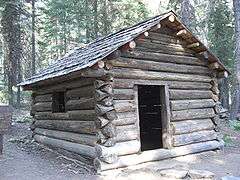Kaweah Colony

The Kaweah Colony was a utopian socialist community in central California founded in 1886. Located in the Sierra Nevada range, they lived near groves of giant sequoia trees. The colony officially disbanded in 1892. The establishment of Sequoia National Park in 1890 contributed to the colony's demise. Some of their descendants still reside in the area.
History
Establishment
Inspired by the writings of Laurence Gronlund, colony leaders attempted to apply the ideals of scientific socialism. The writings of United States socialist Edward Bellamy also influenced the project. This colony based its economy on logging. Membership cost $500 with $100 payable upon application and the remainder in installments of cash or labor. Estimated nationwide membership peaked at 300-500 individuals, many of whom were non-resident supporters. The colony published the local area's first newspaper.
Kaweah Colony was noteworthy for its exploration of giant sequoia groves. The colony originally named what is now known as the General Sherman tree the Karl Marx tree. The only remaining structure from the group's tenure at Sequoia is the Squatter's Cabin, now listed on the National Register of Historic Places.[1]
Demise and legacy
The colony ran into legal problems when they attempted to continue operations after the creation of the national park, which was California's first national park and only the second in the U.S. A Los Angeles court convicted them of illegal logging. For more than four decades some colonists attempted to gain government compensation for the loss of their logging claims, but were not successful.[2]
Kaweah lives on in name at Twin Oaks Community, a contemporary intentional community of 100 members in Virginia. All Twin Oaks' buildings are named after communities that no longer exist, and "Kaweah" is the name of the largest and most eco-featured residence.
Coordinates: 36°28′11″N 118°55′06″W / 36.46972°N 118.91833°W[3]
Footnotes
- ↑ "Squatter's Cabin". List of Classified Structures. National Park Service. 2008-12-08.
- ↑ "The History of Kaweah Colony". The Kaweah Commonwealth. Retrieved December 26, 2013.
- ↑ "Kaweah". Geographic Names Information System. United States Geological Survey.
Further reading
- Robert V. Hine, California's Utopian Colonies. San Marino, CA: Huntington Library, 1953; pp. 78-100.
- Stacy C. Kozakavich, The Center of Civilization: Archaeology and History of the Kaweah Co-operative Commonwealth. PhD dissertation, UC Berkeley, 2007, AAT 3279627.
- J.J. Martin, "A Cooperative Commonwealth: The Kaweah Colony," The Nationalist [Boston], vol. 1, no. 6 (Oct. 1889), pp. 204-208.
- Carey McWilliams, Factories in the Field. New York: Little, Brown and Co., 1939.
- Jay O'Connell, Co-Operative Dreams: A History of The Kaweah Colony. Los Angeles: Raven River Press, 1999.
External links
- Kaweah Commonwealth Online
- United States Park Service publication about Kaweah Colony
- Norton, Marc. "The Karl Marx Tree: How Southern Pacific Railroad killed a socialist colony in the name of creating Yosemite National Park," Red Hills, August 27, 2014.